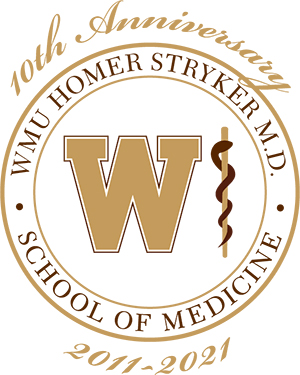 The year 2021 was another significant milestone for WMed as we celebrated the 10-year anniversary of the medical school. Watch our 10th anniversary video to learn more about history and all that we have accomplished.
The year 2021 was another significant milestone for WMed as we celebrated the 10-year anniversary of the medical school. Watch our 10th anniversary video to learn more about history and all that we have accomplished.
We have achieved tremendous success during our first decade because of the active engagement of our faculty, staff, residents, fellows, students, and the broader medical school community.
- We have achieved accreditation as an institution of higher learning and, where available, accreditation for many of our individual programs, which provides external validation that we consistently meet the highest standards for quality and excellence.
- We currently have 337 students enrolled in our M.D. program as well as a master degree program in Biomedical Sciences.
- Our faculty are recognized nationally and internationally as thought leaders in medical education resulting from their roles in creating and developing the medical school’s innovative curriculum.
- Our success preparing medical students for residency training is demonstrated by a 99% or better match rate each year with our graduates entering highly competitive residency programs throughout the United States.
- All of our residency training positions in our graduate medical education programs are consistently filled; we currently have more than 240 residents and fellows training in 10 residencies and five fellowships serving patients throughout southwest Michigan.
- WMed Health, the medical school’s clinical practice, offers more than 36 comprehensive primary care and specialty services in Kalamazoo and Battle Creek, providing more than 67,000 outpatient visits per year.
- Our Department of Pathology faculty serve as the Office of the Medical Examiner (coroner) for counties throughout Michigan and northern Indiana, performing more than 1,000 autopsies each year.
- Our research programs and accomplishments span basic laboratory research, clinical research including creating the Center for Clinical Research, translational research including assimilating the Innovation Center, community-based research, and educational research, resulting in attracting substantial extramural funding and peer recognition.
- The 2020 economic impact of the medical school attributable to organizational and student spending equates to 1,600 new jobs and a $353 million increase in output or sales in Kalamazoo and Calhoun counties.
The Empowering Futures Gift
Building upon the $100 million foundational gift in 2011, the medical school received a philanthropic commitment of $300 million to support the mission of the medical school in June 2021. The Empowering Futures Gift is intended to support student success; build diversity, equity and inclusion in medical education; expand access and opportunity through scholarships; and foster innovation, collaboration, and discovery.
WMed Live: A First Decade Celebration
WMed celebrated its first 10 years of accomplishments and the retirement of Founding Dean Hal B. Jenson, MD at a live virtual gala on May 27, 2021. The community also welcomed the new dean, Dr. Paula M. Termuhlen, during this special event.
- May 2021: Dean Termuhlen Joins the Medical School
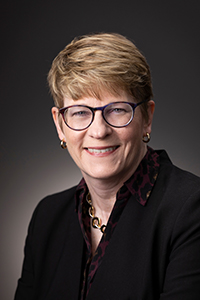
Paula M. Termuhlen, MD, FACS On May 1, 2021 the medical school welcomed Paula M. Termuhlen, MD, FACS as the new dean. Her selection follows a national search to find a successor for founding dean Hal B. Jenson, MD, MBA, who retired in May after 10 years leading WMed. Dr. Termuhlen is a brilliant surgeon and academic leader who will continue to build on our legacy and take the medical school to even greater levels of national distinction.
Dr. Termuhlen is a professor of surgery and has been the regional dean for the Duluth Campus at the University of Minnesota Medical School since 2015, serving more than 130 students in their first two years of medical school and 50 faculty educators and scientists in the mission of training physicians for rural and Native American communities. Prior to that, she was a member of the faculty at the University of Nebraska Medical Center, Wright State University Boonshoft School of Medicine, and the Medical College of Wisconsin. She served as a general surgery residency program director at Wright State University and the Medical College of Wisconsin. She was also vice chair of the Department of Surgery at Wright State University. While at the Medical College of Wisconsin, she led the development team for the creation of two new regional campuses in Green Bay and central Wisconsin.
Dr. Termuhlen is a graduate of Saint Louis University School of Medicine and completed her general surgery training at the University of Texas Health Science Center in Houston and a surgical oncology fellowship at MD Anderson Cancer Center. She is widely published in surgical oncology and surgical education. Dr. Termuhlen is a past president of the Association of Program Directors in Surgery and an inaugural member of the Academy of Master Surgeon Educators. Additionally, she has served in a variety of roles for the American College of Surgeons, Association of American Medical Colleges, Accreditation Council for Graduate Medical Education, National Board of Medical Examiners United States Medical Licensing Examination.
- Our Founding Dean
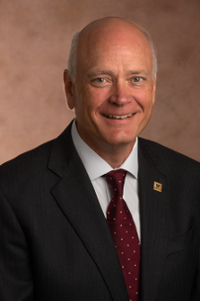
Dr. Hal B. Jenson, Founding Dean Hal B. Jenson, MD, MBA served as our founding dean throughout WMed’s first decade from March 2011 to May 2021 establishing an institution of higher learning that offers the full continuum of undergraduate, graduate, and continuing medical education. He provided outstanding leadership in development and support of the medical school’s guiding principles – the mission, vision, values, values in action, and six strategies. During his tenure, he created an engaged medical school community of learners, faculty, and staff that has achieved tremendous success during its first decade as evidenced by consistently high match rates and USMLE scores, residency and fellowship program growth, advancement of knowledge through faculty scholarly activity, and recognition of excellence by accrediting agencies. Founding Dean Jenson demonstrated relentless commitment, tireless effort, as well as loyalty, and extraordinary dedication to medical school students, residents, fellows, faculty, staff, donors, alumni, patients and families. Watch a video in celebration of our Founding Dean.
At the WMed Live: A First Decade Celebration virtual gala on May 27, 2021, the medical school community honored the Founding Dean upon his retirement. At the event, several anonymous gifts were made to recognize Dean Jenson's accomplishments including:
- The deanship was endowed and all future deans will be named the Hal B. Jenson MD Dean.
- The Master of Science in Biomedical Sciences degree program was endowed and named the Hal B. Jenson, MD Master of Science in Biomedical Sciences degree program.
- A gift was made to name the research floors on the W.E. Upjohn M.D. Campus as the Hal B. Jenson MD Research Institute.
As of May 1, 2021 Dr. Jenson serves as Dean Emeritus and Professor Emeritus in the Department of Pediatric and Adolescent Medicine. He is Board Certified in Pediatric Infectious Diseases. He is a graduate of Brigham Young University with a BS in Zoology (Toxicology) in 1975. He also has a MS from Brigham Young University in Zoology in 1977. He earned his MD from George Washington University in 1979. He completed his residency in Pediatrics from Case Western Reserve University in June 1982. He then completed a fellowship in Pediatric Infectious Diseases and Epidemiology from Yale University School of Medicine in June 1995. He also has an MBA in Business from the University of Texas at Austin-McCombs School of Business in 2003. - 2016 to 2018: Accreditation Milestones and WMed "Firsts" Achieved
The medical school has marked several other milestones during the early years. In 2016, the medical school was granted accreditation, provisional status, by the LCME and was named as a Candidate for institutional accreditation with the Higher Learning Commission. In March 2017, the medical school was certified by the U.S. Department of Education for our students having eligibility to participate in federal financial aid.
On July 31, 2017, WMed welcomed the Class of 2021, its fourth class of medical students and its first full class of 84 students.
In February 2018, WMed was granted full accreditation for a five-year period from the Liaison Committee on Medical Education. Five years is the maximum possible for a new school receiving its initial full accreditation. On March 16, 2018 the inaugural class of medical students participated in Match Day, when medical students across the nation learn where they will spend the next three or more years in residency training. On May 13, 2018, 48 students participated in the inaugural commencement as they were hooded and the degree doctor of medicine was conferred upon them.
The graduation of our first class of medical students marked the end of the "firsts" as WMed itself graduated from being a "new" medical school.
- August 2014: Inaugural Class of Medical Students Arrive
Five months later, on August 18, 2014, the medical school welcomed its inaugural class, which was selected from a pool of more than 3,500 applicants and was comprised of 24 women and 30 men from 14 states, including 23 students from Michigan and 15 from California. The students represented 35 colleges and universities from across the country. Three students were WMU graduates and two were Kalamazoo College alumni. One member of the class attended college as a Kalamazoo Promise scholarship recipient.
The first-year medical students were honored on September 17, 2014, during a White Coat Ceremony and reception at the W.E. Upjohn M.D. Campus. In the presence of family and guests, the students were welcomed into the medical community by leaders and faculty of the medical school and ceremonially cloaked with their first white coat. That day, they stood to take the oath committing them to the profession of medicine. The ceremony impressed upon the students the primacy of the doctor-patient relationship. Click here to watch the first White Coat Ceremony.
- September 2014: Grand Opening Celebration
The Grand Opening Celebration for the downtown medical school building was held on September 18, 2014, with more than 1,500 guests attending. Dean Jenson, President Dunn, Borgess and Bronson CEOs Paul Spaude and Frank Sardone, as well as keynote speaker AAMC Board Chair A. Lorris Betz, MD, spoke at the ceremony to welcome the new medical students to Kalamazoo, recognize donor and community support, and to showcase the new medical education facility. Click here to watch a video of highlights from the event or click here to watch the entire ceremony.
- WMed Named After Homer Stryker M.D.
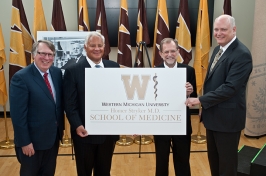
The medical school was named for Dr. Homer H. Stryker on March 11, 2014. On March 11, 2014, the new medical school was named for Dr. Homer H. Stryker, a WMU alumnus and founder of Stryker Corporation. The naming honored the wishes of donors of the $100 million gift, Stryker's granddaughter, Ronda Stryker, and her husband William Johnston, a WMU trustee.
- W.E. Upjohn M.D. Campus Development
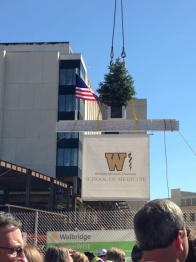
The "topping out" ceremony for the renovation and addition at the W.E. Upjohn M.D. Campus was held on October 2, 2013. On October 12, 2012, a groundbreaking ceremony was held at the site of the new downtown medical school building on the W.E. Upjohn M.D. Campus. During the groundbreaking ceremony, Dean Jenson announced that WMed was granted preliminary accreditation from the Liaison Committee on Medical Education (LCME), permitting WMed to move forward to recruit its first class of medical students.
Rapid progress was made on the $68 million renovation and addition at the W.E. Upjohn M.D. Campus. Just one year after the groundbreaking, on October 2, 2013, several hundred colleagues, community leaders and friends of the medical school gathered to sign the final steel beam that signaled the "topping out" of the new addition on the medical school building in downtown Kalamazoo. In June 2014, the facility was ready to welcome the faculty, staff, and students who would occupy the newly renovated medical education facility.
- July 2012 Merger of MSU/KCMS
In July 2012, the Michigan State University Kalamazoo Center for Medical Studies (MSU/KCMS) Board of Directors approved the merger into WMed. Under the terms of the merger, all MSU/KCMS operations, programs, personnel and facilities became part of WMed. The merger included the clinical education and patient care programs, administrative functions, 223 staff, 200 residents and 61 full-time faculty. Additionally, more than 420 physicians from the Kalamazoo community volunteer their time as clinical faculty at MSU/KCMS to extend the educational experiences for medical students and residents into their private offices. From that foundation, the medical school has added several new residency and fellowship training programs, increased the size of training programs, and had significant growth in the numbers of full-time faculty and also community volunteer faculty.
- Building Donated for Medical Education Facility
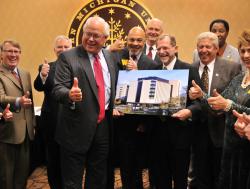
On December 8, 2011, William U. Parfet donated to WMU a 350,000 square-foot building in downtown Kalamazoo. After a major renovation and addition, this building now serves as the W.E. Upjohn M.D. Campus of the medical school. Less than six months after the historic announcement, on December 8, 2011, William U. Parfet, then the chairman and chief executive officer of MPI Research and the great-grandson of W.E. Upjohn, donated to WMU a 350,000 square-foot building in downtown Kalamazoo that now serves as the W.E. Upjohn M.D. Campus of the medical school. Our downtown campus, which is on the original plot of land acquired by W. E. Upjohn to begin The Upjohn Company, at one time housed the very research facility where drugs such as Motrin, Xanax, Halcion, Rogaine, and Zyvox were discovered. Locally known as Pfizer Building 267, the property is adjacent to Bronson Healthcare, only three miles from Borgess Health and two miles from WMU and the Oakland Drive Campus of the medical school.
- March 22, 2011: $100 million Gift Announced
Founding Dean Dr. Hal B. Jenson’s first day on the job -- March 22, 2011 – was the same day that a $100 million cash gift to WMU was announced to serve as the foundation funding for WMed. At the time, the anonymous gift was the largest ever made to a Michigan college or university, the 10th largest cash gift ever made to an American public university, and the 15th largest cash gift in the history of American higher education. Today, proceeds from the gift remain invested in a dedicated reserve and the investment return and principal is available for the unrestricted use of WMed.
- Medical School Development: 2007 to 2011

WMU President John M. Dunn (Photo Courtesy of MLive Media Group) At WMed, we are rooted in the heart of Kalamazoo, a Michigan city with a proud history of excellence in education, healthcare, research and life-science exploration – all of which are assets for the continued growth of the medical school.
A recognition of those rich resources led John M. Dunn, then the new president of Western Michigan University, to challenge the community to consider the development of a medical school during his first Academic Convocation and State of the University address in October 2007. President Dunn's address sparked community interest and within six weeks a Medical School Feasibility Committee was formed. In 2008, consultants were retained to conduct detailed feasibility assessments and by January 2009, the feasibility studies confirmed what President Dunn had observed – Kalamazoo possessed the substantial assets and necessary building blocks to establish an outstanding medical school.
Together, with the collaboration of WMU, Borgess Health and Bronson Healthcare, President Dunn’s vision transformed quickly into reality and, in November 2009, an anonymous donation of $1.8 million buoyed efforts and planning for WMed. A committee comprised of President Dunn and the chief executive officers of Borgess and Bronson met regularly to guide the development process. In 2010, WMed was awarded applicant status by the Liaison Committee on Medical Education (LCME), a search committee was developed to recruit the school’s founding dean, and Jack Luderer, MD, was named interim dean. After a national search, Hal B. Jenson, MD, MBA, was named WMed’s founding dean in January 2011.
- Medical Education in Kalamazoo Before the Medical School
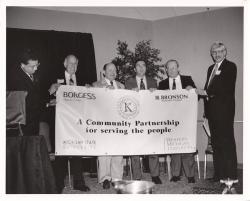
The Michigan State University Kalamazoo Center for Medical Studies was unveiled in 1989. The roots of medical education and excellence in Kalamazoo can be traced back to 1946 when the Upjohn Company, the Kalamazoo Foundation and the W.E. Upjohn Trustee Corporation contributed to a grant establishing the first graduate medical education program in Kalamazoo – a residency training program in internal medicine at Bronson Methodist Hospital. Shortly thereafter, Borgess Medical Center began its internship and residency training programs.
In considering the impact of graduate medical education in Kalamazoo, the Upjohn Board of Directors wrote at the time that "the institutions as well as the communities they serve benefit richly from the services of resident staffs, and the quality of medical care rises sharply under the responsibility posed by teaching."
The Upjohn Board had the foresight to recognize that the presence of graduate medical education in Kalamazoo would significantly contribute to the city’s reputation as a medical community, rich in hospital resources and in businesses such as Pharmacia & Upjohn, Inc., and the Stryker Corporation.
For many years, Borgess and Bronson independently offered numerous internship and residency programs. In 1966, the first joint residency program between the hospitals – an Orthopaedic Surgery program – was created.
The success of the joint residency program, as well as a shared desire to strengthen graduate medical education in Kalamazoo, led both hospitals in 1973 to form the Southwest Michigan Area Health Education Center (SMAHEC), a non-profit organization devoted to medical education. However, SMAHEC's corporate structure was not conducive to respond to national changes in health care and, in 1989, Michigan State University’s College of Human Medicine was added as a corporation partner as SMAHEC transitioned under a new name: Michigan State University Kalamazoo Center for Medical Studies.
The appellation aptly reflected the renewed direction of the organization. MSU brought an academic focus to the corporation, with Kalamazoo serving as a regional clinical campus of the MSU medical school and having faculty in Kalamazoo appointed by MSU, recognizing faculty teaching roles.
In 1994, the clinics and administrative offices, which had been scattered throughout the city, came together at one location – the University Medical and Health Sciences Center on Oakland Drive. The center was renovated to offer state-of-the-art learning facilities and position the institution to continue medical student and resident training in a world of healthcare increasingly focused on outpatient care. The building's name symbolized the symbiotic relationship of two universities, two hospitals, and medicine and health.

